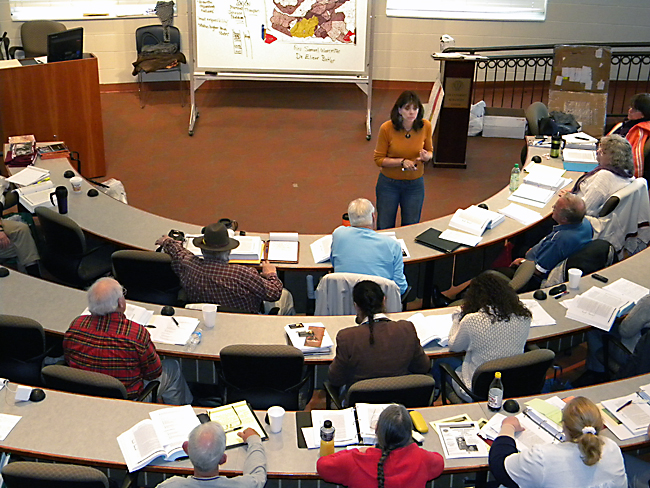 Dr. Julia Coates, an elected member of the Cherokee National Council and an assistant professor at the University of California at Davis, led a two-weekend Cherokee history class attended by about 100 people from seven states. The class was in the Johnson Lecture Room at Lee University's Humanities Center.
Staff Photo by Randall Higgins/Chattanooga Times Free Press
Dr. Julia Coates, an elected member of the Cherokee National Council and an assistant professor at the University of California at Davis, led a two-weekend Cherokee history class attended by about 100 people from seven states. The class was in the Johnson Lecture Room at Lee University's Humanities Center.
Staff Photo by Randall Higgins/Chattanooga Times Free PressCLEVELAND, Tenn. - There are two histories of the Cherokee Indians.
There's the one most people know concerning the 1838 forced march known as the Trail of Tears.
And there's the one that's written in treaties, court pleas and court decisions, political debates and congressional votes, letters and newspaper articles.
Julia Coates, historian and assistant professor at the University of California at Davis, led about 100 people from seven states through the Cherokee paper trail over two weekends in a Lee University lecture hall. Coates also is an elected member of the Cherokee National Council, the nation's legislative wing.
"It has always been that we have something that somebody else wants," from lush Appalachian mountains, North Georgia gold and prime western grazing land to oil and, these days, casino locations, she said.
The course is required for the 8,000 or so employees of the Cherokee Nation's various enterprises. On rare occasions, the course has come to Chattanooga; Rome, Ga.; or somewhere else in the old Cherokee country.
Principal Chief Chadwick Corntassel Smith developed the course, Coates said.
"He found that the people themselves didn't know their own history," she said.
The Trail of Tears is not the final chapter of the book; it's actually in the middle of the story, so far. What came after were years of political war and a century and a half of court and political battles to keep national treaty rights and even the Cherokee Nation's identity.
Since the 1970s, meanwhile, the Cherokee Nation has become an economic force in Northeast Oklahoma - the ending place for the Trail of Tears - with tourism and tribal industrial enterprise, Coates said.
The Lee University class had a varied set of students, many of them teachers. Some claimed Cherokee heritage. A teenager was earning credit hours for her home schooling course, and some people were just there to learn.
University of Tennessee legend Johnny Majors was one of the latter.
"I've always been a history buff," the former head football coach said during a class break. "I enjoy fiction, but I guess 80 percent of my reading is history. I can't resist a bookstore."
Majors said he has traveled to historical sites around the world, from battlefields of the American Civil War to Normandy beaches, site of the D-Day landing in France, and other World War II sites.
Rosemary McConkey, an Irish writer researching a book on Appalachia, took the course to understand more about the interactions of early mountain settlers with the Cherokees and others.
"I want to understand the Cherokee culture and the mindset of both the Cherokees and the Scotch-Irish settlers," she said. "It's very challenging to hear the voices perpetuated in these documents."
Coates' visit to Lee was coordinated by Debbie Moore with help from the Bradley County Historical and Genealogical Association, the Charleston/Calhoun/Hiwassee Historical Society and Lee University.
"I think this has been a time of consciousness raising for all of us," Lee anthropology professor Murl Dirksen said Sunday as the class ended. "It comes at a time when this area is rediscovering its Cherokee story as well as observing its Civil War past. I would ask everybody to remember the Cherokees and make something meaningful here, not just a tourist stop."
Contact Randall Higgins at rhiggins@timesfreepress.com or 423-314-1029.